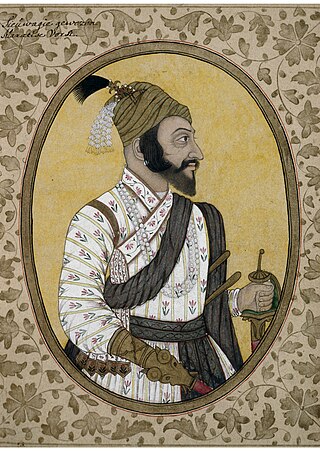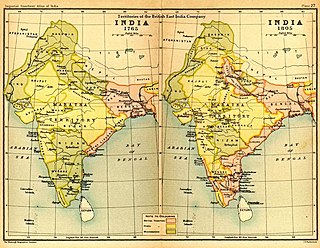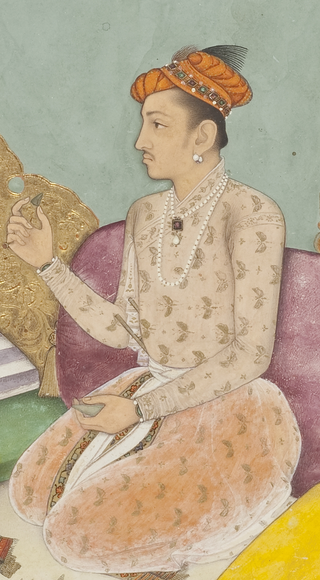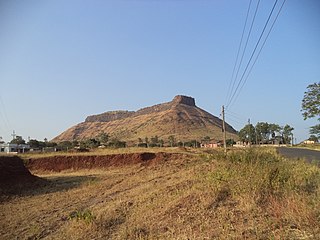
The Third Battle of Panipat took place on 14 January 1761 between the Maratha Confederacy and the invading army of the Durrani Empire. The battle took place in and around the city of Panipat, approximately 97 kilometres (60 mi) north of Delhi. The Afghans were supported by three key allies in India: Najib ad-Dawlah who persuaded the support of the Rohilla chiefs, elements of the declining Mughal Empire, and most prized the Oudh State under Shuja-ud-Daula. The Maratha army was led by Sadashivrao Bhau, who was third-highest authority of the Maratha Confederacy after the Chhatrapati and the Peshwa. The bulk of the Maratha army was stationed in the Deccan Plateau with the Peshwa.

Shivaji I was an Indian ruler and a member of the Bhonsle Dynasty. Shivaji carved out his own independent kingdom from the declining Adilshahi Sultanate of Bijapur that formed the genesis of the Maratha Empire. In 1674, he was formally crowned the Chhatrapati of his realm at Raigad Fort.

The Maratha Empire also referred to as the Maratha Confederacy was an early modern Indian empire and later a confederation that controlled large portions of the Indian Subcontinent in the 18th century. Maratha rule formally began in 1674 with the coronation of Shivaji of the Bhonsle dynasty as the Chhatrapati. Although Shivaji came from the Maratha caste, the Maratha empire also included warriors, administrators, and other nobles from the Maratha and several other castes from what is known today as Maharashtra. The Maratha Kingdom was expanded into a full-fledged Empire in the 18th Century under the leadership of Peshwa Bajirao I.

The Battle of Tukaroi, also known as the Battle of Bajhaura or the Battle of Mughulmari, was fought between the Mughal Empire and the Bengal Sultanate on 3 March 1575 near the village of Tukaroi in present-day Balasore District of Odisha. It resulted in a Mughal victory and greatly weakened the Bengal Sultanate.

Rajaram Bhonsle I was the third Chhatrapati of Maratha Empire, who ruled from 1689 to his death in 1700. He was the second son of the Shivaji, the founder of the empire and younger half-brother of Sambhaji, who he succeeded. His eleven-year reign was marked with a constant struggle against the Mughals. He was succeeded by his infant son Shivaji II under the regentship of his dowager Maharani Tarabai.

The Deccan wars were a series of military conflicts between the Mughal Empire and the descendants of the Maratha ruler Shivaji from the time of Shivaji's death in 1680 until the death of Emperor Aurangzeb in 1707. Shivaji was a central figure in what has been called "the Maratha insurgency" against the Mughal state. Both he and his son, Sambhaji, or Shambuji, typically, alternated between rebellion against the Mughal state and service to the Mughal sovereign in an official capacity. It was common practice in late 17th-century India for members of a ruling family of a small principality to both collaborate with the Mughals and rebel.

The Battle of Pratapgad took place on 10 November 1659, at Pratapgarh Fort in Satara. The battle was fought between the Maratha forces led by Chhatrapati Shivaji and the Bijapur troops under General Afzal Khan. The Marathas emerged victorious, marking their first significant military triumph against a major regional power. In the aftermath of this victory Shivaji captured 65 elephants, 4000 horses, 1200 camels and 10 Lakh rupees of cash and jewelry.

The Maratha Conquests were a series of conquests in the Indian subcontinent which led to the building of the Maratha Empire. These conquests were started by Shivaji in 1659, from the victory at the Battle of Pratapgad against Bijapur. The expansion of the empire was limited and interrupted by the Mughal conquests of south India by Mughal ruler Aurangzeb until he eventually died in 1707 in Deccan itself. Marathas were forced to defend their territories against the overwhelmingly strong Mughal army in the 27 years long Deccan wars. They were able to defend their territories and gain an upper hand over Mughals in the sustained conflict.

Battle of Surat, also known as the Sack of Surat, was a land battle that took place on 5 January 1664, near the city of Surat, in present-day Gujarat, India, between Shivaji, leader of the fledgling Maratha Confederacy and Inayat Khan, a Mughal commander. The Marathas defeated the Mughal military unit posted at Surat and ransacked the city.

The Battle of Sinhagad, also known as Battle of Kondhana, involved an attack by the forces of the Maratha Empire during the night of 4 February 1670 on the fort of Sinhagad, near the city of Pune, Maharashtra. The Marathas captured the fort.
Santaji Ghorpade (1660–1696) was a Maratha general and held the esteemed position of the 7th Senapati within the Maratha Empire during the reign of Chattrapati Rajaram I. He is widely regarded as one of the foremost experts in Guerrilla warfare. Santaji Ghorpade, in collaboration with Dhanaji Jadhav, conducted a series of successful campaigns against the Mughals from 1689 to 1696. His strategic acumen was demonstrated through the adept utilization of tactics such as guerrilla warfare, ambushes, and swift mobility, ultimately resulting in effective defeats of the Mughal Army. In recognition of his valor, Rajaram bestowed upon him the title of Mamlakat-Madar in 1690.

Mirza Raja Jai Singh I was the senior most general and a high ranking mansabdar at the imperial court of Mughal Empire as well as the Kachwaha ruler of the Kingdom of Amber. His predecessor was his grand uncle, Mirza Raja Bhau Singh, the younger son of Mirza Raja Man Singh I.
The Battle of Lalsot was fought between the Rajputs of Jaipur and Jodhpur against Marathas under Mahadji Scindia to collect taxes from the Rajput States. Mahadji as the Naib Vakil-i-Mutlaq of the Mughal Emperor, demanded Rs.63,00,000 from the Jaipur court, however these demands were refused, upon which Mahadji marched against Jaipur with his army. A part of the Mughal army under Hamdani deserted and defected to the Rajput army before the battle.

The Maratha Army was the land-based armed forces of the Maratha Empire, which existed from the late 17th to the early 19th centuries in the Indian subcontinent.
The Battle of Salher was fought between the Marathas and the Mughal Empire in February 1672 CE. The battle was fought near the fort of Salher in modern day Nashik district. The result was a decisive victory for the Marathas. This battle is considered particularly significant as it is the first pitched battle where the Mughal Empire lost to the Marathas.

Ahmad Shah Durrani, the founder of the Durrani Empire, invaded Indian subcontinent for eight times between 1748 and 1767, following the collapse of Mughal Empire in the mid-18th century. His objectives were met through the raids and deepened the political crisis in India.

Siege of Ramsej was a series of military confrontations between the Maratha Empire headed by Sambhaji and the Mughal Empire led by Aurangzeb regarding the control of Ramsej Fort in the Nashik region. Aurangzeb arrived in the Deccan in late 1681 with a strong army to destroy the Maratha Empire and the Deccan Sultanates of Adilshahi and Qutubshahi. He wanted to capture the forts held by the Marathas in the Nashik and Baglana regions. Hence he decided to begin his Deccan campaign with an attack on Ramsej Fort which is near Nashik. The Mughal forces under Kasim Khan Kirmani captured Ramsej from the Marathas. The defending Maratha forces evacuated the fort.
The Battle of Bhatvadi was fought in 1624, near modern Bhatodi Pargaon village in Maharashtra, India. The Ahmadnagar army led by Malik Ambar defeated a combined Mughal-Bijapur force led by the Bijapuri general Mullah Muhammad Lari.

Shivaji's Campaign of Jawali was a military engagement fought between the forces of the Maratha Empire, led by Shivaji and the Bijapur Sultanate, under the command of Chandra Rao More, in the year 1656.This battle took place near the town of Jawali, located in present-day Maharashtra, India.

The loss of Panhala took Bijapur by alarm. Bhalol Khan set out with an army of 12000 to check the Maratha offensive. Shivaji despatched Prataprao Gujar both forces clashed at Umarrani 45 KM west of Bijapur.
















